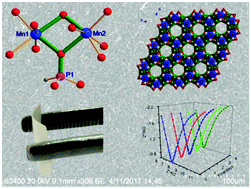An open-framework manganese(ii) phosphite and its composite membranes with polyvinylidene fluoride exhibiting intrinsic water-assisted proton conductance†
Abstract
Proton conducting materials have important technological applications as key components in electrochemical devices, including fuel cells, electrochemical sensors, electrochemical reactors and electrochromic displays. And the exploration of novel proton conducting materials is significant for the development of efficient electrochemical devices. In this study, we have investigated the proton conductance of an open-framework manganese(II) phosphite, (NH4)0.59(H3O)1.41Mn5(HPO3)6 (1). The open-framework manganese(II) phosphate shows superior water-stability and excellent thermal stability. There was intrinsic water-assisted proton conductivity with σ = 3.94 × 10−4 S cm−1 at 328 K and 98% RH. Furthermore, composite membranes have further been fabricated using polyvinylidene fluoride (PVDF) and 1, labeled as 1@PVDF-X, where the symbol X represents the mass percentage of 1 (as X%) in the composite membrane and X = 10–55%. The composite membranes display good mechanical performance and durability for practical applications, and the proton conductivity of 1@PVDF-55 reaches 3.32 × 10−5 S cm−1 in deionized water at 336 K.



 Please wait while we load your content...
Please wait while we load your content...